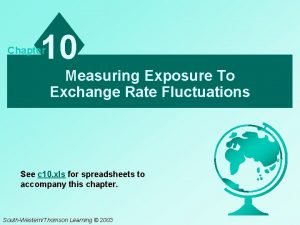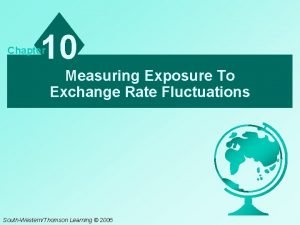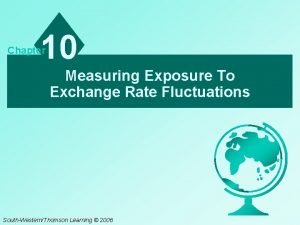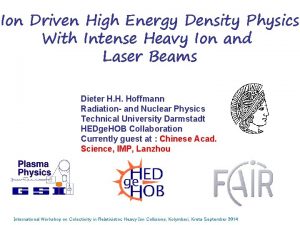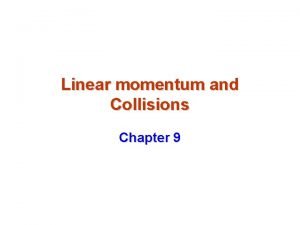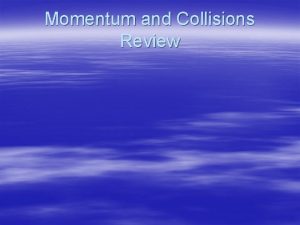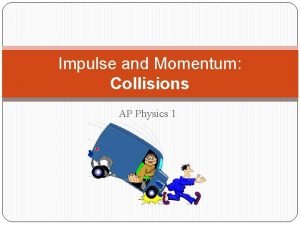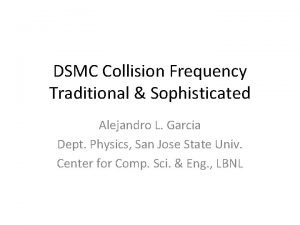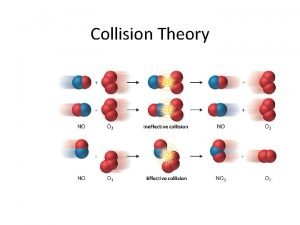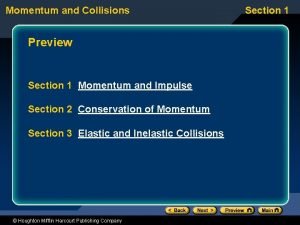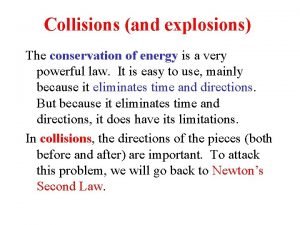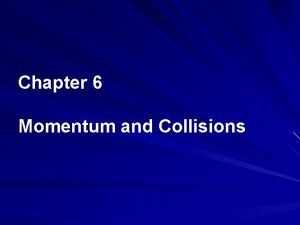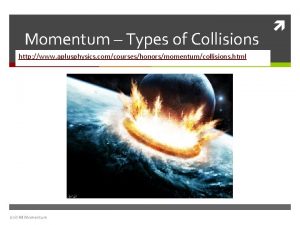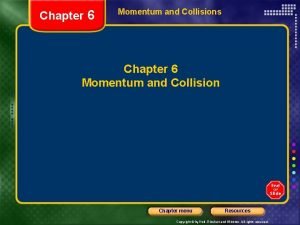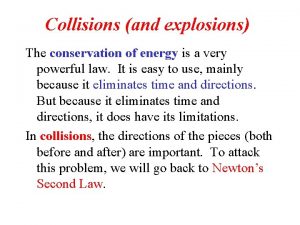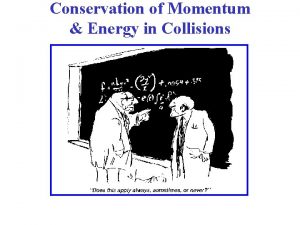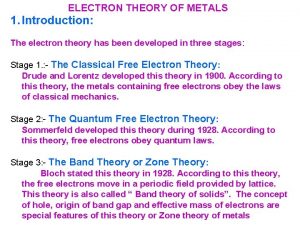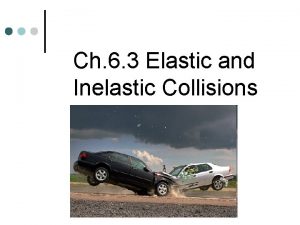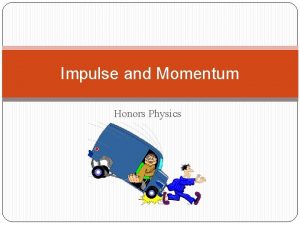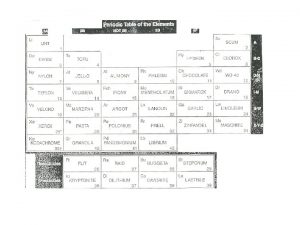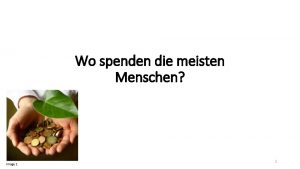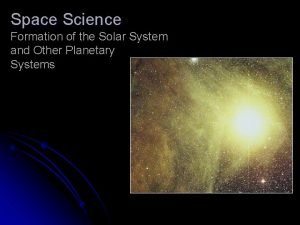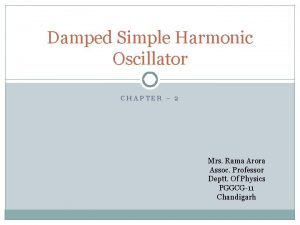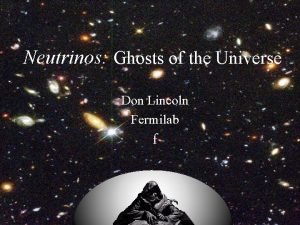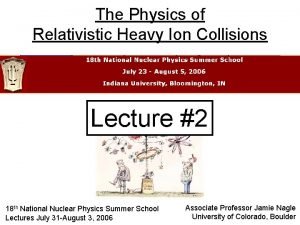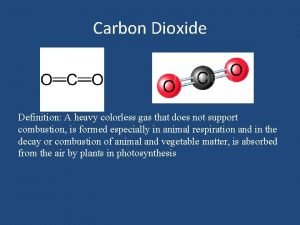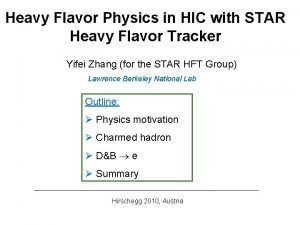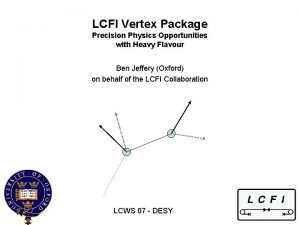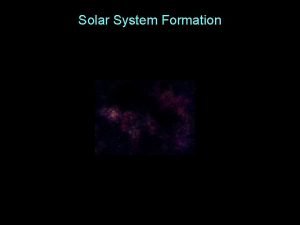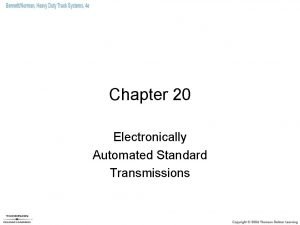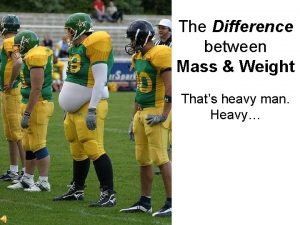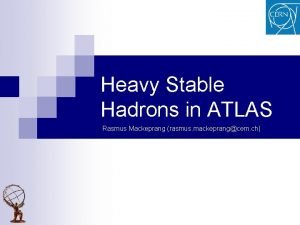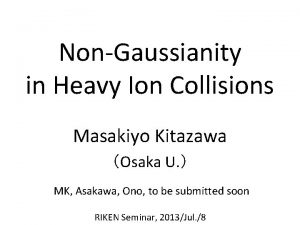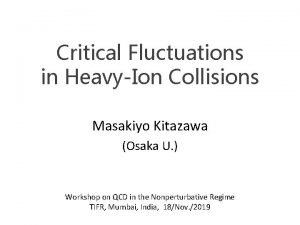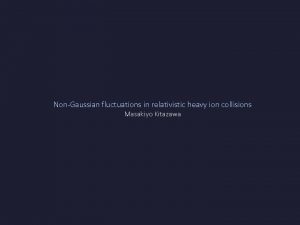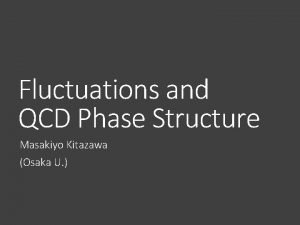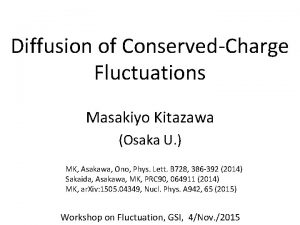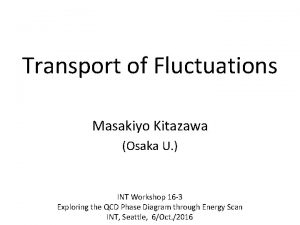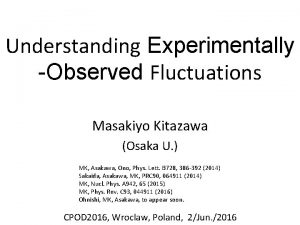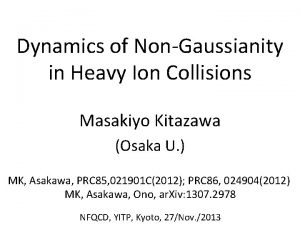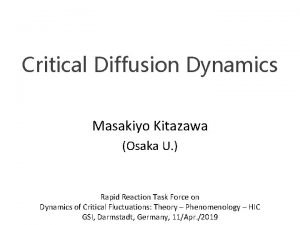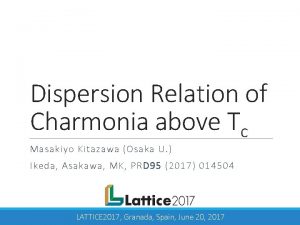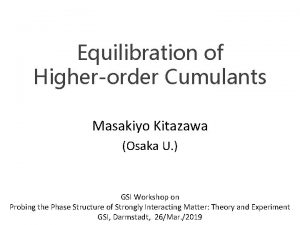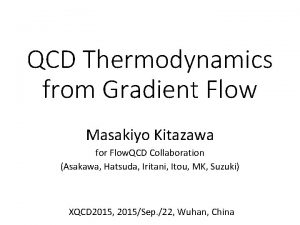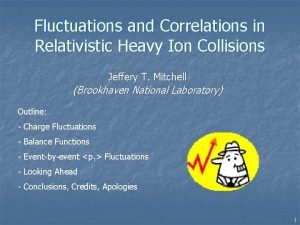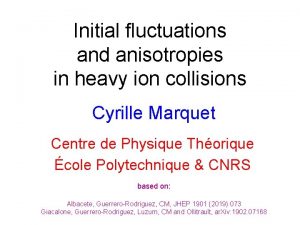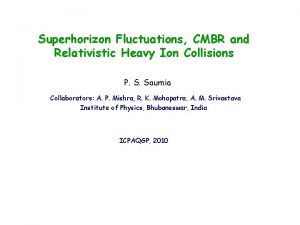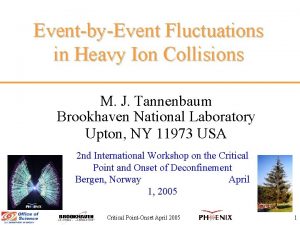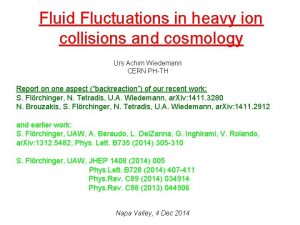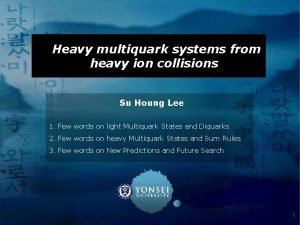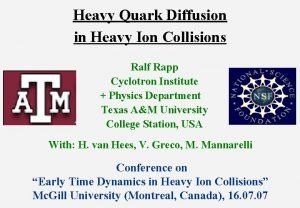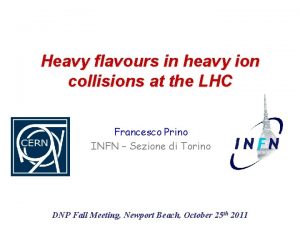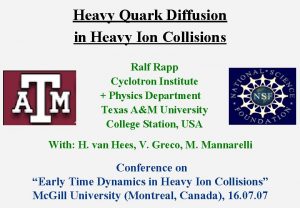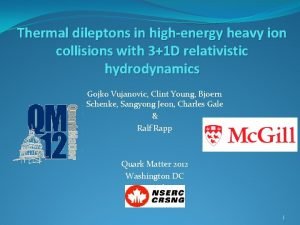Thermal Fluctuations in Heavy Ion Collisions Masakiyo Kitazawa







































































- Slides: 71

Thermal Fluctuations in Heavy Ion Collisions Masakiyo Kitazawa (Osaka U. )

Beam-Energy Scan T Quark-Gluon Plasma Hadrons Color SC 0 m

Beam-Energy Scan STAR 2012 high bea T me ner gy low Hadrons Color SC 0 m

Bulk (Thermal) Fluctuations Observables in equilibrium are fluctuating! variance V Gaussian non-Gaussianity

Event-by-Event Analysis Detector Pioneering studies on s : p Search of QCD critical point Stephanov, Rajagopal, Shuryak, PRL(1998) p Quark deconfinement Asakawa, Heinz, Muller PRL; Jeon, Koch PRL(2000)

My Messages p Fluctuations are invaluable observables in HIC p But, we must understand them in more detail p It’s possible, interesting, and important

Why Fluctuations?

Brownian Motion from Wikipedia A. Einstein 1905 Fluctuations opened atomic physics

Shot Noise at Normal-Superconductor Junction X. Jehl+, Nature 405, 50 (2000) current normal super Normal Super Normal Similar experiments for fractional QHE ex. Saminadayar+, PRL 79, 2526(1997)

Conserved Charges : Theoretical Advantage p Definite definition for operators - as a Noether current - calculable on any theory ex: on the lattice

Conserved Charges : Theoretical Advantage p Definite definition for operators - as a Noether current - calculable on any theory ex: on the lattice p Simple thermodynamic relations - Intuitive interpretation for the behaviors of cumulants ex: Asakawa, Ejiri, MK, 2009

Conserved-Charge Fluctuations of CC : rigorously defined in a theory • operators as the Noether current • as derivatives of the partition function They are lattice observables Fluctuations of CC = LAT-HIC crossover QCD phase diagram 3, Wed. 11: 00 -13: 30

Recent Progress in Lattice Community From LATTICE 2013 presentations

Fluctuations Free Boltzmann Poisson

Fluctuations Free Boltzmann Poisson RBC-Bielefeld ’ 09

Electric Charge Fluctuation Asakawa, Heinz, Muller; Jeon, Koch, 2000 D-measure • D ~ 3 -4 Hadronic • D ~ 1 -1. 5 QGP

Electric Charge Fluctuation PHENIX (2002); STAR (2003) ALICE, PRL 110, 152301 (2013) hadronic D measure STAR Suppression @ LHC energy • D ~ 3 -4 Hadronic • D ~ 1 -1. 5 QGP • No suppression at RHIC energy • Fluctuations @ LHC cannot be described by hadronic d. o. f.

Rapidity Window Dependence ALICE, PRL 110, 152301 (2013) hadronic • Smaller Dh more hadronic • Larger Dh more QGP like Stochastic Diffusion eq. Same information in • • balance function to be studied by fluctuating hydro. Shuryak, Stephanov, 2001

Time Evolution in HIC Quark-Gluon Plasma Hadronization Freezeout

Various Contributions p Initial fluctuations p Effect of jets Enhance p Negative binomial (? ) Enhance to Poisson p Final state rescattering Enhance to Poisson p Coordinate vs pseudo rapidities p Particle miss. ID Enhance to Poisson p Efficiency correction Enhance to Poisson p Global charge conservation Suppress

Global Charge Conservation For equilibrated medium Jeon, Koch, 2000 Bleicher, Jeon, Koch, 2001

Global Charge Conservation For equilibrated medium Jeon, Koch, 2000 Bleicher, Jeon, Koch, 2001 Solving the time evolution… detector coverage GCC effect on the hadronic diffusion is negligible in the ALICE result! Sakaida, Poster I-35

Electric-Charge Fluctuations p Electric charge fluctuations is suppressed at LHC! p The suppression is most probably attributed to primordial physics p Qualitative difference b/w RHIC and LHC … but why?

Non Gaussianity

Non-Gaussianity CMB Cosmic Microwave Background • No statistically-significant signals Planck, 2013 Mesoscopic Systems • Full counting statistics • Cumulants up to 5 th order Gustavsson+, Surf. Sci. Rep. 64, 191(2009)

Non-Gaussianity in HIC p Ratio of conserved charges Ejiri, Karsch, Redlich(2005) p Critical enhancement Stephanov(2009) p Sign change Asakawa, Ejiri, MK (2009); Friman+(2011); Stephanov(2011) p Strange confinement BNL-Bielefeld(2013) p Distribution funcs themselves Morita+(2013); Nakamura (Wed. )

Ratio of Cumulants hadronic quark-gluon Ejiri, Karsch, Redlich, 2005

Strange Confinement Baryonic BNL-Bielefeld, PRL(2013) H. T. Ding, This Morning baryons confined something else Strangeness strangeness confined something else Many lattice studies (LAT-HIC crossover): Budapest-Wuppertal, 2013; BW, 1403. 4578; BNL-Bi. , 1404. 4043; Gupta+, 1405. 2206; Ratti, Wed. ; Schmidt, Wed. ; Nakamura, Wed. ; Sharma, J-13

Cumulants : HIC@RHIC vs Lattice parameter window constrained by lattice BNL-Bielefeld, LATTICE 2013 fluctuations “exp + lattice” m /T discrepancy particle abundance (chem. freezeout T)

Proton Number Cumulants at RHIC-BES STAR, PRL 112, 032302(2014) p Exp. results are close to and less than Poissonian values. p Something interesting around STAR 2012

Effects of Various Contributions p Initial fluctuations p Effect of jets Enhance p Negative binomial (? ) Enhance to Poisson p Final state rescattering Enhance to Poisson p Coordinate vs pseudo rapidities p Particle miss. ID Enhance to Poisson p Efficiency correction Enhance to Poisson p Global charge conservation Suppress

Caution!! proton number cumulants baryon number cumulants Let’s clarify their relation! MK, Asakawa (2012; 2012)

Nucleon isospin and a coin N p n Nucleon has two isospin states. A coin has two sides. MK, Asakawa, 2012

Slot Machine Analogy = +

Reconstructing Total Coin Number

Charge Exchange Reaction Isospin of N is not frozen at chemical freezeout! cross sections of p 2 1: 2 1 2: 1 3 decay rates of D mean reaction time < 5 fm/c

Nucleons in Hadronic Medium kinetic f. o. hadronize chem. f. o. time mesons baryons NOTE: • so many pions • rare NN collisions • no quantum corr.

Difference b/w NB and Np Assumptions: net-cumulants deviate from thermal value But, are Poissoian genuine info. noise Proton number cumulants are dominated by Poissonian noise cf. ) Nahrgang+, ar. Xiv: 1402. 1238

Efficiency Correction If efficiency for each particle is uncorrelated MK, Asakawa, 2012 Bdzak, Koch, 2012 STAR, 2013 Electric charge binomial correction to distribution function STAR, ar. Xiv: 1402. 1558 for Particle miss. ID: Ono, Asakawa, MK, PRC, 2013

More Information on/from Fluctuations Dh dependence MK, Asakawa, Ono, PLB 728, 386 (2014)

Dh Dep. of Non-Gaussianity enhance? suppress? How does the 4 -th order cumulant behave as a function of Dh?

Fluctuating Hydrodynamics? p Distributions in experiments are close to Poissonian p Cumulants are expected to increase in the hadronic medium These behaviors cannot be described by theory of hydrodynamic fluctuations

Hydrodynamic Fluctuations Landau, Lifshitz, Statistical Mechaniqs II Kapusta, Muller, Stephanov, 2012 Stephanov, Shuryak, 2001 Stochastic diffusion equation Markov (white noise) + continuity Fluctuation of n is Gaussian in equilibrium Gaussian noise cf) Gardiner, “Stochastic Methods”

How to Introduce Non-Gaussianity? Stochastic diffusion equation p Choices to introduce non-Gaussianity in equil. : p n dependence of diffusion constant D(n) p colored noise p discretization of n

How to Introduce Non-Gaussianity? Stochastic diffusion equation p Choices to introduce non-Gaussianity in equil. : p n dependence of diffusion constant D(n) p colored noise p discretization of n our choice Fluctuations measured in REMARK: HIC are almost Poissonian.

Nucleons in Hadronic Medium Baryons in hadronic medium behave like Browinian pollen kinetic f. o. hadronize chem. f. o. time mesons baryons

Diffusion Master Equation MK, Asakawa, Ono, PLB 728, 386(2014) Divide spatial coordinate into discrete cells probability Master Equation Solve the DME exactly, and take a 0 limit

hadronization chemical freezeout Brownian diffusion Initial condition • boost invariance • locality of fluctuations • small cumulants kinetic freezeout Comments: • agreement with stochastic diffusion eq. up to Gaussian fluctuaion • Poisson (Skellam) distribution in equilibrium: consistent with HRG

Solution of DME in a 0 Limit 1 st order (deterministic) p consistent with diffusion equation with D=ga 2 Continuum limit with fixed D=ga 2 2 nd order p consistent with stochastic diffusion eq. (for sufficiently smooth initial conditions) Shuryak, Stephanov, 2001 Nontrivial results for non-Gaussian fluctuations

Net Charge Number Prepare 2 species of (non-interacting) particles Let us investigate at freezeout time t

Time Evolution in Hadronic Phase Hadronization (initial condition) p Boost invariance / infinitely long system p Local equilibration / local correlation suppression owing to strongly dependent on local charge conservation hadronization mechanism

Time Evolution in Hadronic Phase Time evolution via DME Hadronization (initial condition) Freezeout p Boost invariance / infinitely long system p Local equilibration / local correlation suppression owing to strongly dependent on local charge conservation hadronization mechanism

Dh Dependence at Freezeout Initial fluctuations: 2 nd 4 th parameter sensitive to hadronization

Total Charge Number In recombination model, 6 quarks 6 antiquarks p can fluctuate, while does not.

Dh Dependence at Freezeout Initial fluctuations: 2 nd 4 th parameter sensitive to hadronization

th 4 order Cumulant at ALICE MK, Asakawa, Ono (2014) Sakaida+, poster I-35 rapidity coverage at ALICE 4 th order cumulant is sensitive to initial fluctuation / transport property / confinement It can be non-monotonic and negative!

Dh Dep. of Non-Gaussianity enhance? suppress? How does the 4 -th order cumulant behave as a function of Dh?

Suggestions to Experimentalists p many conserved charges electric charge, baryon number, (and strangeness? ) with different diffusion constans p various cumulants second, third, fourth, mixed, (and much higher? ) p Dh window dependences primordial thermodynamics, transport property, confinement no normalization p Beam Energy Scan LHC, RHIC-BES, FAIR, NICA, J-PARC, …

My Messages p Fluctuations are invaluable observables in HIC p But, we must understand them in more detail p It’s possible, interesting, and important We are just arriving at the starting point to explore QCD phase structure with fluctuations!

Summary Fluctuations in HIC are nonthermal! Plenty of physics in Dh dependences of various cumulants Physical meanings of fluctuation obs. in experiments. Diagnosing dynamics of HIC p history of hot medium p mechanism of hadronization p diffusion constant

backup

Dh Dependence at STAR, QM 2012 decreases as Dh becomes larger at RHIC energy.

Probability Distribution p p Detector Ø for any phase space in the final state. binomial distribution func.

3 rd & 4 th Order Fluctuations

Strange Baryons Decay Rates: Decay modes: Regarding these ratios even, protons from these decays is incorporated into the binomial distribution. Then, NN NB

Dh Dependence at Freezeout Initial fluctuations: 2 nd 4 th parameter sensitive to hadronization

Total Charge Number In recombination model, 6 quarks 6 antiquarks p can fluctuate, while does not.

Higher Order Cumulants @ STAR (Net-) Proton Number STAR, PRL 112, 032302(2014) (Net-) Electric Charge STAR, ar. Xiv: 1402. 1558 p Exp. results are close to Poissonian values. p Proton number cumulants are lower than the Poissonian values.

nd 2 Order Cumulant consistent with stochastic diffusion equation

Search of QCD Phase Structure Stronger correlation length dep. Sign of cumulants Stephanov, 2009 Asakawa, Ejiri, MK, 2009 Friman+, 2011 Stephanov, 2011

Fluctuations p Fluctuations reflect properties of matter. p Enhancement near the critical point Stephanov, Rajagopal, Shuryak(’ 98); Hatta, Stephanov(’ 02); Stephanov(’ 09); … p Ratios between cumulants of conserved charges Asakawa, Heinz, Muller(’ 00); Jeon, Koch(’ 00); Ejiri, Karsch, Redlich(’ 06) p Signs of higher order cumulants Asakawa, Ejiri, MK(’ 09); Friman, et al. (’ 11); Stephanov(’ 11)
 Ratey method
Ratey method Measuring exposure to exchange rate fluctuations
Measuring exposure to exchange rate fluctuations Advantages of non coherent mti radar
Advantages of non coherent mti radar Transaction exposure
Transaction exposure Measuring exposure to exchange rate fluctuations
Measuring exposure to exchange rate fluctuations Key facts about economic fluctuations
Key facts about economic fluctuations Heavy ion
Heavy ion Ejemplo de fuerza ion ion
Ejemplo de fuerza ion ion Fuerzas dipolo dipolo ejemplos
Fuerzas dipolo dipolo ejemplos Ion ion interaction
Ion ion interaction Ejemplo de fuerza ion ion
Ejemplo de fuerza ion ion Section 3 using thermal energy worksheet answer key
Section 3 using thermal energy worksheet answer key Thermal transfer vs direct thermal printing
Thermal transfer vs direct thermal printing Elastic collision vs inelastic
Elastic collision vs inelastic Formula of collision
Formula of collision Momentum and collisions review
Momentum and collisions review Ap physics collisions
Ap physics collisions Is momentum conserved in all collisions
Is momentum conserved in all collisions What is collision frequency
What is collision frequency Slidetodoc.com
Slidetodoc.com Collisions
Collisions Collisions and explosions
Collisions and explosions To avoid collisions a defensive driver should
To avoid collisions a defensive driver should Chapter 16 driving on highways
Chapter 16 driving on highways To avoid collisions a defensive driver should
To avoid collisions a defensive driver should Momentum and collisions
Momentum and collisions Aplusphysics momentum-conservation answer key
Aplusphysics momentum-conservation answer key Chapter 6 momentum
Chapter 6 momentum Collisions and explosions
Collisions and explosions How do we know momentum is conserved
How do we know momentum is conserved Electron theory of metals
Electron theory of metals Prévention des collisions engins-piétons
Prévention des collisions engins-piétons Types of collisions
Types of collisions Types of collisions
Types of collisions Whats linear momentum
Whats linear momentum Elastic collision video
Elastic collision video Heavy symmetric top
Heavy symmetric top Heavy komparativ
Heavy komparativ Heavy elements formed
Heavy elements formed Snap heavy duty concentrate
Snap heavy duty concentrate B heavy molasses
B heavy molasses What are s-cam type foundation brakes mounted to
What are s-cam type foundation brakes mounted to Heavy metal pollution
Heavy metal pollution Heavy lift and transport lake charles
Heavy lift and transport lake charles Swingline heavy duty tacker #800
Swingline heavy duty tacker #800 Relaxation time of damped harmonic oscillator
Relaxation time of damped harmonic oscillator Heavy weather by weather report
Heavy weather by weather report Come unto me, all who are weak weary and heavy laden lyrics
Come unto me, all who are weak weary and heavy laden lyrics Dimension of simple harmonic motion
Dimension of simple harmonic motion Heavy water
Heavy water Heavy ions
Heavy ions Colorless gas
Colorless gas Heavy looking rather portentous man
Heavy looking rather portentous man Heavy equipment caterpillar warning symbols
Heavy equipment caterpillar warning symbols Heavy growth of coliform
Heavy growth of coliform One way ticket to midnight heavy metal
One way ticket to midnight heavy metal Charm mesom
Charm mesom Prolan heavy
Prolan heavy Heavy flavour
Heavy flavour Hurts just a little bit scale
Hurts just a little bit scale Tss of heavy tomato puree
Tss of heavy tomato puree Foreshadowing in the lottery
Foreshadowing in the lottery Heavy elements formed
Heavy elements formed Heavy duty truck systems
Heavy duty truck systems Heavy damping graph
Heavy damping graph That's heavy man
That's heavy man Heavy equipment safety poster
Heavy equipment safety poster A heavy container has been raised up above ground level
A heavy container has been raised up above ground level Rasmus mackeprang
Rasmus mackeprang Which of the following processes involve heat?
Which of the following processes involve heat? Are you weary are you heavy hearted
Are you weary are you heavy hearted The single inverted bronze bowl
The single inverted bronze bowl

